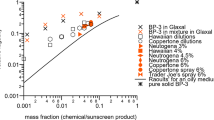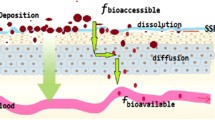Abstract
Mutual enhancement of dermal absorption of N,N-diethyl-m-toluamide (DEET) and oxybenzone (OBZ) has been reported recently with DEET and OBZ being active ingredients of insect repellent and sunscreen, respectively. To assess the reported enhancing effect directly, we used human urinary metabolites as biomarkers; besides, we also sought to determine the best way for concurrent use of these two products without extra absorption of either. Four dermal application methods were used: DEET only (S1), OBZ only (S2), DEET on top of OBZ (S3), and OBZ on top of DEET (S4). Among the study methods, there was a significant difference (p = 0.013), which was attributed to the difference between S1 and S4, suggesting that applying OBZ over DEET on the skin lead to significantly higher absorption of DEET. Using both products in reverse order, (S3) did not result in extra DEET absorption significantly. As for OBZ permeation, no significant difference was observed among the methods. In summary, the enhancement of DEET absorption is confirmed for OBZ being applied over DEET on the skin; should concurrent use of both be necessary, applying sunscreen (OBZ) first and then insect repellent (DEET) with a 15-min interval is recommended.




Similar content being viewed by others
References
Brand RM, Spalding M, Mueller C (2002) Sunscreens can increase dermal penetration of 2,4-dichlorophenoxyacetic acid. J Toxicol Clin Toxicol 40:827–832
Constantino L, Iley J (1999) Microsomal metabolism of N,N-diethyl-m-toluamide (deet, det): the extended network of metabolites. Xenobiotica 29:409–416
FDA (U.S. Food and Drug Administration) (2007) Insect repellent-sunscreen drug products for over-the-counter human use: Request for information and comments. Fed Reg 72(35):7941–7945, http://www.gpo.gov/fdsys/granule/FR-2007-02-22/E7-2890/content-detail.html
Fediuk DJ, Wang T, Chen Y, Parkinson FE, Namaka MP, Simons KJ, Burczynski FJ, Gu X (2011) Tissue disposition of the insect repellent deet and the sunscreen oxybenzone following intravenous and topical administration in rats. Biopharm Drug Dispos 32:369–379
Fediuk DJ, Wang T, Chen Y, Parkinson FE, Namaka MP, Simons KJ, Burczynski FJ, Gu X (2012) Metabolic disposition of the insect repellent deet and the sunscreen oxybenzone following intravenous and skin administration in rats. Int J Toxicol 31:467–476
Gonzalez HG, Farbrot A, Larkö O (2002) Percutaneous absorption of benzophenone-3, a common component of topical sunscreens. Clin Exp Dermatol 27:691–694
Gonzalez H, Jacobson CE, Wennberg AM, Larko O, Farbrot A (2008) Solid-phase extraction and reverse-phase HPLC: application to study the urinary excretion pattern of benzophenone-3 and its metabolite 2,4-dihydroxybenzophenone in human urine. Anal Chem Insights 3:1–7
Gu X, Kasichayanula S, Fediuk DJ, Burczynski FJ (2004) In-vitro permeation of the insect repellent N,N-diethyl-m-toluamide (deet) and the sunscreen oxybenzone. J Pharm Pharmacol 56:621–628
Gu X, Wang T, Collins DM, Kasichayanula S, Burczynski FJ (2005) In vitro evaluation of concurrent use of commercially available insect repellent and sunscreen preparations. J Pharm Pharmacol 152:1263–1267
Kasichayanula S, House JD, Wang T, Gu X (2005) Simultaneous analysis of insect repellent deet, sunscreen oxybenzone and five relevant metabolites by reversed-phase HPLC with UV detection: application to an in vivo study in a piglet model. J Chromatogr B Analyt Technol Biomed Life Sci 822:271–277
Kasichayanula S, House JD, Wang T, Gu X (2007) Percutaneous characterization of the insect repellent deet and the sunscreen oxybenzone from topical skin application. Toxicol Appl Pharmacol 223:187–194
Moody RP, Benoit FM, Riedel D, Ritter L (1989) Dermal absorption of the insect repellent deet (N,N-diethyl-m-toluamide) in rats and monkeys: effect of anatomical site and multiple exposure. J Toxicol Environ Health 26:137–147
Nakagawa Y, Suzuki T (2002) Metabolism of 2-hydroxy-4-methoxybenzophenone in isolated rat hepatocytes and xenoestrogenic effects of its metabolites on MCF-7 human breast cancer cells. Chem Biol Interact 139:115–128
Okereke CS, Kadry AM, Abdel-Rahman MS, Davis RA, Friedman MA (1993) Metabolism of benzophenone-3 in rats. Drug Metab Dispos 21:788–791
Okereke CS, Barat SA, Abdel-Rahman MS (1995) Safety evaluation of benzophenone-3 after dermal administration in rats. Toxicol Lett 80:61–67
Osimitz TG, Murphy JV (1997) Neurological effects associated with use of the insect repellent N,N-diethyl-m-toluamide (deet). J Toxicol Clin Toxicol 35:435–441
Pont AR, Charron AR, Wilson RM, Brand RM (2003) Effects of active sunscreen ingredient combinations on the topical penetration of the herbicide 2,4-dichlorophenoxyacetic acid. Toxicol Ind Health 19:1–8
Pont AR, Charron AR, Brand RM (2004) Active ingredients in sunscreens act as topical penetration enhancers for the herbicide 2,4-dichlorophenoxyacetic acid. Toxicol Appl Pharmacol 195:348–354
Qiu H, Jun HW, McCall JW (1998) Pharmacokinetics, formulation, and safety of insect repellent N,N-diethyl-m-methylbenzamide (deet): a review. J Am Mosq Control Assoc 14:12–27
Ross EA, Savage KA, Utley LJ, Tebbett IR (2004) Insect repellent interactions: sunscreens enhance deet (N,N-diethyl-m-toluamide) absorption. Drug Metab Dispos 32:783–785
Santhanam A, Miller MA, Kasting GB (2005) Absorption and evaporation of N,N-diethyl-m-toluamide from human skin in vitro. Toxicol Appl Pharmacol 204:81–90
Schoenig GP, Hartnagel RE, Osimitz TG, Llanso S (1996) Absorption, distribution, metabolism, and excretion of N,N-diethyl-m-toluamide in the rat. Drug Metab Dispos 24:156–163
Selim S, Hartnagel RE Jr, Osimitz TG, Gabriel KL, Schoenig GP, Journals O (1995) Absorption, metabolism, and excretion of N,N-diethyl-m-toluamide following dermal application to human volunteers. Fundam Appl Toxicol 25:95–100
Smallwood AW, DeBord KE, Lowry LK (1992) N,N-diethyl-m-toluamide (m-det): analysis of an insect repellent in human urine and serum by high-performance liquid chromatography. J Anal Toxicol 16:10–13
Taylor WG, Spooner RW (1990) Identification and gas chromatographic determination of some carboxylic acid metabolites of N,N-diethyl-m-toluamide in rat urine. J Agricult Food Chem 38:1422–1427
Tian JN, Yiin LM (2014) Urinary metabolites of N,N-diethyl-m-toluamide (DEET) after dermal application on child and adult subjects. J Environ Health 76:162–169
U.S. EPA (U.S. Environmental Protection Agency) (2007) Insect repellent-sunscreen combination products; request for information and comments. Fed Reg 72(35):7979–7983, http://www.gpo.gov/fdsys/pkg/FR-2007-02-22/html/E7-3008.htm
Wang T, Gu X (2007) In vitro percutaneous permeation of the repellent deet and the sunscreen oxybenzone across human skin. J Pharm Pharm Sci 10:17–25
Wang T, Kasichayanula S, Gu X (2006) In vitro permeation of repellent deet and sunscreen oxybenzone across three artificial membranes. J Pharm Pharmacol 310:110–117
Wu A, Lynn Pearson M, Shekoski DL, Soto RJ, Stewart RD (1979) High resolution gas chromatography/mass spectrometric characterization of urinary metabolites of N,N-diethyl-m-toluamide (deet) in man. J High Resolut Chromatogr 2:558–562
Ye X, Kuklenyik Z, Needham LL, Calafat AM (2005) Quantification of urinary conjugates of bisphenol A, 2,5-dichlorophenol, and 2-hydroxy-4-methoxybenzophenone in humans by online solid phase extraction-high performance liquid chromatography-tandem mass spectrometry. Anal Bioanal Chem 383:638–644
Acknowledgments
The authors thank all participating subjects for their efforts in dermal testing and urine sampling. This study was funded by Grants from the National Science Council of Taiwan (NSC 94-2314-B-320-012 and NSC 95-2314-B-320-011) and partly supported by Tzu Chi University Supplement Grants (610400184-01 and 610400184-02).
Author information
Authors and Affiliations
Corresponding author
Additional information
Responsible editor: Philippe Garrigues
Rights and permissions
About this article
Cite this article
Yiin, LM., Tian, JN. & Hung, CC. Assessment of dermal absorption of DEET-containing insect repellent and oxybenzone-containing sunscreen using human urinary metabolites. Environ Sci Pollut Res 22, 7062–7070 (2015). https://doi.org/10.1007/s11356-014-3915-3
Received:
Accepted:
Published:
Issue Date:
DOI: https://doi.org/10.1007/s11356-014-3915-3




